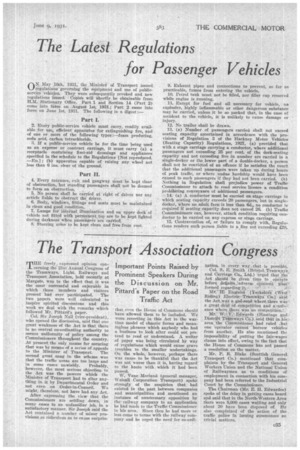The Latest Regulations for Passenger Vehicles
Page 57

If you've noticed an error in this article please click here to report it so we can fix it.
(AN May 16th, 1931; the Minister of Transport issued, kJ regulations governing" the equiptuent and use of publicservice 'vehicles. They were subsequently revoked and new regulations issued. Copies will shortly be obtainable front H.M. Stationary Office. Part 1 and -Section 14 (Part 2) come into ft:4ft on August 1st4 1931; Part 2 came into force on ;Tune 1st, 1931. The following is a digest:—
2. Every •public-service 'vehicle must carry, readily available for use efficient apparatus for extinguishing fire, and of one or More of the following types :—foam producing, soda acid, carbon tetrachloride, 8. If a public-service vehicle be for the time being used as an express or contract carriage, it must carry (a) a receptacle containing first-aid dressings and appliances specified in the schedule to the Regulations [Not reproduced, —ED.] ; (b) apparatus capable of raising any wheel net less than 6 ins, clear of the ground.
4. Every entrance, exit and gangwaY ninst: be kept clear of obsteuction,Aut standing passengers shall not be deemed to form an obstruction....... •
5. No person shall be carried, at 'right of driver nor any
article liable to obstruct the driver. . . • .
6. Body, windows, fittings and seats must be maintained in clean and good condition.
7. Lampsfor internal illumination and on upper deck of Vehicle not fitted with Permanent tent are to be kept lighted during darkness when passengers are carried.
S. Steering arina to be kept clean and free from rust. 9. Exhaust pipes and connections to prevent, so far as Practicable, fumes from entering the vehicle.
10. Petrol tank must not be filled, nor filler cap removed while engine is running.
11. Except for fuel and oil necessary for vehicle, no explosive, highly inflammable or other dangerous substance may be carried, unless it be so packed that, in the case of accident to the vehicle, it is unlikely to cause damage or injury.
12. No trailer shall be drawn.
13. (a) Number of passengers carried shall not exceed seating capacity ascertained in accordance with the provisions of Regulation 3 of the Hackney Motor Vehicles (Seating Capacity): Regulations, 1927, (a) provided that with a stage carriage carrying a conductor, where additional passengers not exceeding 25 per cent, of the deck-seating capacity and not exceeding five -in number are carried in a single-decker or the lower part eta double-decker, a person shall not be convicted of an offence if he satisfies the court that the additional passengers were taken up during hours of peak traffic, or where undue hardship would have been caused to such passengers if they had not been carried. (b) Nothing in Regulation shall prejudice power of Traffic Commissioner to attach to road service licence a condition prohibiting conveyance of additional passengers.
14. (a) A conductor must be carried on stage carriage in which seating capacity exceeds 20 passengers, but in singledecker, where no adult fare, is less than 6c1.., no conductor is reckuired if seating capacity does not exceed 26. (b) Traffic Cominiasinners can, however, attach condition requiring conductor to be carried 'on any express or stage carriage.
15. Contravention of, or failure to comply with, Regulations renders such person liable to a.fine not exeeeding 420,












































































































